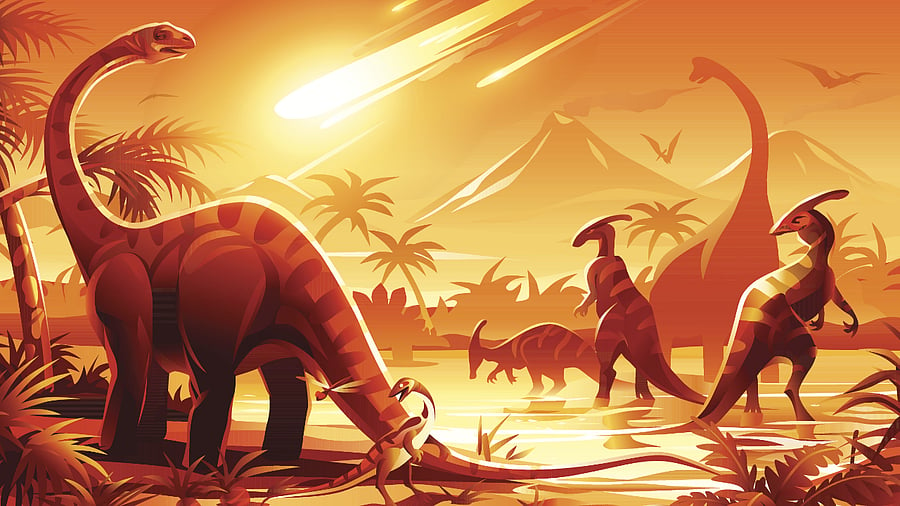
Detailed illustration of a prehistoric scene showing a meteor impact causing dinosaur extinction.
Credit: iStock Images
Though the dinosaurs walked this planet around 230 million years ago they have always remained an enigma for the common man. Thus, even the tiniest secrets uncovered about them is nothing short of striking gold.
Their exact timing of evolution remains under speculation. However, what we do know is that these vertebrates appeared during the Triassic period and were the dominating beings right through the Mesozoic era.
In order to solve the enigma that surrounds them, researchers over the years set out to discover all they could about dinosaurs by looking for their fossils. Estimates suggest approximately 11,000 dinosaur fossils have been unearthed around the globe.
While analysing and studying fossils gives one a vague idea of the size and structure of the dinosaurs themselves, it becomes a tad bit difficult to decipher their eating habits, which could have been crucial to their survival, given the environmental conditions and changes in the Mesozoic era.
Making sure no stone is left unturned in their quest to understand how dinosaurs lived, researchers at the Uppsala University in Sweden examined fossilised dinosaur poop, which revealed fascinating insights into the lives of the giant reptiles.
According to a report by Interesting Engineering, fossilised feces (also known as coprolites) were discovered in the Polish Basin in Central Europe. After examining these fossils, they discovered that dinosaurs at the time fed on fish and insects, as well as larger animals and plants.
Martin Qvarnström, PhD, a researcher at the Department of Organismal Biology at Uppsala University and lead author of the study told the publication that he, along with his colleague Grzegorz Niedźwiedzki, PhD, examined hundreds of samples of fossilised dinosaur feces and realised they could uncover the secret behind ancient food chains.
Along with colleagues from Norway, Poland, and Hungary, they used advanced synchrotron imaging to examine the hidden structures of fossilised feces.
They examined traces of undigested food such as plants and prey and reconstructed the ecosystems that existed during the time when dinosaurs roamed the Earth.
“The research material was collected over a period of 25 years. It took us many years to piece everything together into a coherent picture,” says Niedźwiedzki.
After conducting the procedure, the team found remains of fish, insects, as well as larger animals, and plants. However, they also found small beetles and nearly complete fish. Some of the coprolites even contained bone fragments chewed up by predators, akin to that of of modern-day hyenas, which crush bones to absorb nutrients.
Researchers found another fascinating discovery from the feces of Smok Wawelski. The dinosaur's name means “dragon of Wawel” in Polish but it is more commonly known as Smok.
“This feeding behavior is seldom associated with theropod dinosaurs, except for T-Rex and its relatives, who used high bite forces to crush bone at the end of the dinosaurs’ rule,” Qvarnström explained.
“We showed that this behavior also characterized some of the early big carnivorous archosaurs; Smok crushed its own teeth while feeding and repeatedly replaced them. We found the teeth in the coprolites, too", Qvarnström further added.
The presence of charcoal in the diets of herbivorous dinosaurs was also a startling finding, the researchers said. "Our hypothesis is that they consumed charcoal to detoxify their stomach contents after eating toxic ferns since we found many ferns in their dropping. But they could also have accidentally ingested the charcoal together with unburnt parts of the plants, as we know that there were widespread wildfires during this time,” said Qvarnström.
Qvarnström also said that this study is the first to approach this time period with an ecological perspective using direct evidence of feeding, something that is particularly important, given that dietary diversity and adaptability would have been crucial for survival amid the environmental shifts of the Late Triassic.
"Based on this research, we have proposed a model for the rise of dinosaurs that involves both opportunism and competition," the scientist said.
